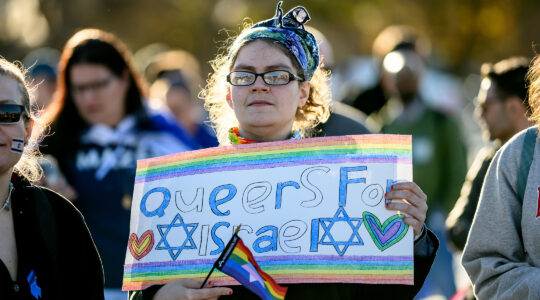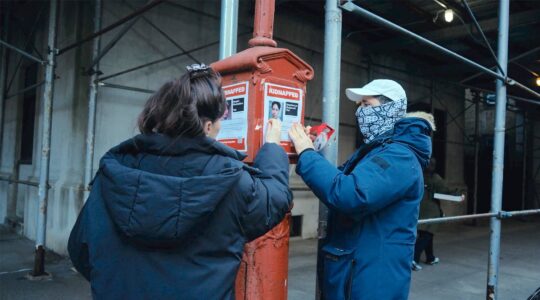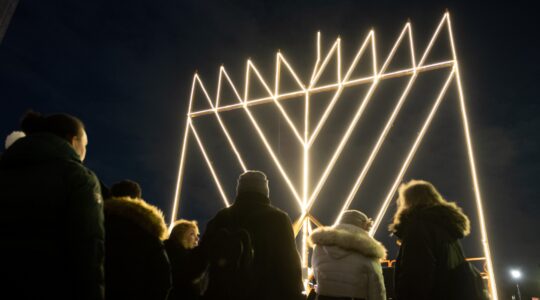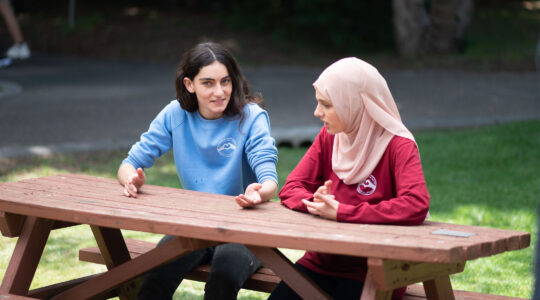NEW YORK (JTA) – Seeing Bob Dylan at a prayer service isn’t all that rare. Hearing a Bob Marley tune played on guitar while a minyan sings the Shema prayer is.
Marley and Dylan tunes are just as likely to be part of the nusach at “Jam Davening” as those of Shlomo Carlebach and Debbie Friedman. The monthly prayer group at the Davidson School of Jewish Education of the Jewish Theological Seminary is part guided meditation, part sing-along, part traditional prayer and part dorm-room musical jam that includes instruments ranging from guitars to didgeridos.
Participants say the result is invigorating and deeply spiritual.
“Tefillah is much broader than what is in the prayer book,” said Yoni Stadlin, a second-year student at the Davidson school who started the minyan about a year ago with fellow students Davey Rosen and Matt Check, along with JTS rabbinical student Andy Shugerman.
“The best tefillah is in your feet and your voice and your hands. It is a communication and an action embodying holiness or kindness and goodness,” he said. “The words in the prayer book are time tested, and they are ours and they have worked and seem to work for many of us, but I don’t limit myself to thinking that prayer is only in that book. It is a great guidebook, but this is much broader.”
Jam Davening draws about double the audience of a typical learning minyan, participants say. Now the group is trying to figure out how to bring Jam Davening to a wider audience, first by inviting the broader seminary community into the minyan, then by taking the idea to individual synagogues.
This comes at a time when music is rapidly being introduced into Conservative synagogues.
Musical instruments had been excluded from Conservative synagogues on Shabbat partially because of Jewish law and partially as a remembrance of the destruction of the Temple in Jerusalem nearly 2,000 years ago. But starting in the 1950s, the movement allowed Conservative congregations to decide for themselves whether to use instruments.
Now as the movement debates whether Jews should be praying for the rebuilding of the Temple or just Jerusalem – and about whether or not the use of electricity on Shabbat is banned – the use of instruments has also come under “healthy debate,” according to Rabbi Moshe Edelman, the director of the Committee on Congregational Standards for the United Synagogue of Conservative Judaism.
Also, members of the Law Committee of the Rabbinical Assembly are working on a paper to address the issue, according to Rabbi Joel Roth, a professor of Talmud and Jewish law and formerly the head of the committee.
At a Monday afternoon Jam Davening service at JTS, Shugerman in tallit spoke contemplatively over the soft strumming of a guitar.
“Take a second, think about the prayer you want,” he told the 30 or so JTS and Davidson students and faculty gathered around a boardroom table.
“Where do you need to connect today? Where do you need to shine that light?” he asked, as the guitar strumming became louder behind him. He picked up a hand-held tarabuka drum, and as he started playing a beat with the guitars, the group broke into a singing recitation of Psalm 113.
“He raises the poor from the dust and lifts the needy from the ash heap,” they sang in Hebrew repeatedly over a simple riff of chords until they crescendoed together.
The start of Jam Davening, like many a musical jam session, was impromptu. Davidson has a weekly participatory learning minyan, where students bring questions and commentary in an attempt to find a deeper meaning and understanding of prayer.
Stadlin and company, who had started jamming together on the back of a tour bus in Israel, decided one day in February to bring music to the minyan, combining some of the tunes from the bus with more traditional prayer tunes and setting the words of the traditional davening to them.
“Once the music really hit and came into our doors, it opened us up a lot in terms of our expressiveness,” said Rabbi Jonathan Lipnick, the rabbi in residence at the Davidson School, who oversees the minyan. “It became about creating this open space for people to share.”
The musical prayer service is still fairly improvisational, and often changes from service to service, as participants go with “whatever is vibing,” as Stadlin put it.
There are some staples, such as the recitation of Shema during the morning prayer session. But Shema might involve the prelude of a song called “Waves” that Yoni learned at a Rainbow Gathering in Israel or a rendition of Bob Marley’s “One Love.” From Marley the music may range from Crosby, Stills, Nash and Young, to the Grateful Dead, to gospel.
“We do a great Freebird Aleinu,” Stadlin said.
And while the debate rages about the use of music in Conservative synagogues, at this minyan it is all about the music and the prayer.
“It is a way of connecting to God and connecting to community and using the treasury of resources we have,” Lipnick said. “The siddur is one ‘cli,’ vessel, that we have. But it is also the music of Debbie Friedman, the music of American gospel and the music of the culture that helps shape our religious souls.”

Help ensure Jewish news remains accessible to all. Your donation to the Jewish Telegraphic Agency powers the trusted journalism that has connected Jewish communities worldwide for more than 100 years. With your help, JTA can continue to deliver vital news and insights. Donate today.





